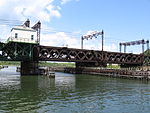The SoNo Collection
The SoNo Collection is an upscale shopping mall in the South Norwalk neighborhood of Norwalk, Connecticut. It was announced and originally developed by GGP Inc. (General Growth Properties) in 2017; it has been owned and managed by Brookfield Properties, a subsidiary of Brookfield Asset Management, since its acquisition of GGP in 2018. The mall opened on October 11, 2019, and is the fourth mall in Fairfield County. The mall has adopted a phased opening process, including interactive art installations and community gathering spaces. It features southern Connecticut’s only Nordstrom and Connecticut's only Bloomingdale's as the anchor stores. It is located next to Interstate 95 and Route 7.
Excerpt from the Wikipedia article The SoNo Collection (License: CC BY-SA 3.0, Authors).The SoNo Collection
North Water Street, Norwalk
Geographical coordinates (GPS) Address External links Nearby Places Show on map
Geographical coordinates (GPS)
| Latitude | Longitude |
|---|---|
| N 41.10511 ° | E -73.419332 ° |
Address
The SoNo Collection
North Water Street 100
06854 Norwalk
Connecticut, United States
Open on Google Maps









